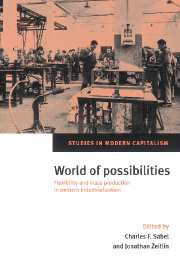Book contents
- Frontmatter
- Contents
- List of contributors
- Acknowledgments
- Stories, strategies, structures: rethinking historical alternatives to mass production
- Part I The modernity of tradition
- 1 Fashion as flexible production: the strategies of the Lyons silk merchants in the eighteenth century
- 2 The fate of collective manufactures in the industrial world: the silk industries of Lyons and London, 1800–1850
- 3 The rise and decline of flexible production: the cutlery industry of Solingen since the eighteenth century
- 4 Manufacturing flexibility in nineteenth-century Switzerland: social and institutional foundations of decline and revival in calico-printing and watchmaking
- Part II The battle of the systems
- Part III The resurgence of flexible production
- Index
3 - The rise and decline of flexible production: the cutlery industry of Solingen since the eighteenth century
Published online by Cambridge University Press: 12 December 2009
- Frontmatter
- Contents
- List of contributors
- Acknowledgments
- Stories, strategies, structures: rethinking historical alternatives to mass production
- Part I The modernity of tradition
- 1 Fashion as flexible production: the strategies of the Lyons silk merchants in the eighteenth century
- 2 The fate of collective manufactures in the industrial world: the silk industries of Lyons and London, 1800–1850
- 3 The rise and decline of flexible production: the cutlery industry of Solingen since the eighteenth century
- 4 Manufacturing flexibility in nineteenth-century Switzerland: social and institutional foundations of decline and revival in calico-printing and watchmaking
- Part II The battle of the systems
- Part III The resurgence of flexible production
- Index
Summary
Introduction
The production of cutlery of all sorts in the industrial area around the city of Solingen in the lower Rhineland of Germany can be seen as a “classical” example of a historical industrial system based on “flexible specialization.”
In many aspects its inner structure as well as its development over a long period of time seems to have been typical of several other export-orientated trades, located in neighboring districts: files and edge-tools in Remscheid, ribbonweaving in Barmen and Ronsdorf, or the diversified silk industries of Elberfleld, Cronenberg and Krefeld. All of them grew out of fairly small artisanal trades, producing for regional and supra-regional markets in the seventeenth century. But they were shaped by the economic and social conditions and experiences of the eighteenth century, becoming large export industries, designed to serve the then existing “world market.” By the late eighteenth century they were seen by many contemporaries as the most important industries of the western parts of Germany.
During the first decades of the nineteenth century the collapse of the old institutional framework, as well as fast changing market-conditions influenced by rising national tariff barriers and – in some cases – superior British competition, brought severe distress to the trades. Only in the second half of the nineteenth century, however, did most of these “flexible specialized” industries reach the peak of their development, now integrating new mechanical devices into their system and logic of production. By contrast, the twentieth century became a time of continuous crisis.
- Type
- Chapter
- Information
- World of PossibilitiesFlexibility and Mass Production in Western Industrialization, pp. 153 - 187Publisher: Cambridge University PressPrint publication year: 1997
- 4
- Cited by



